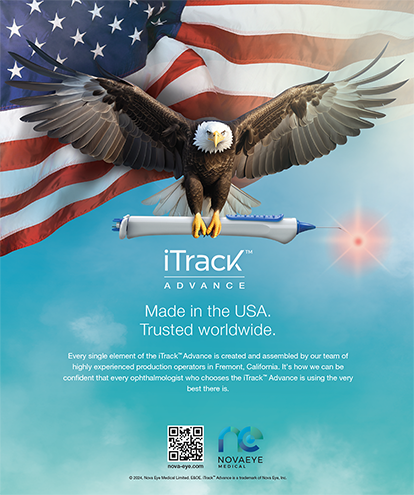The availability of three FDA-approved IOLs for the treatment of presbyopia allows surgeons to customize patients' binocular vision. Recently, my colleagues and I completed a prospective, nonrandomized, five-arm comparative trial of bilaterally implanted ReZoom zonal refractive multifocal IOLs (Advanced Medical Optics, Inc., Santa Ana, CA), bilaterally implanted AcrySof Restor apodized diffractive multifocal IOLs (Alcon Laboratories, Inc., Fort Worth, TX), bilaterally implanted Crystalens accommodating IOLs (Eyeonics, Inc., Aliso Viejo, CA), and combinations of the Crystalens/ReZoom IOLs and the Crystalens/AcrySof Restor IOLs, with the Crystalens implanted in the patient's dominant eye.1 This article shares the outcomes of our study and discusses the possibilities of customizing IOLs to meet each patient's individual needs and lifestyle.
OUR RESULTS
The monocular results paralleled the binocular findings and are summarized in Visual Outcomes in Patients With Various Combinations of Accommodating and Multifocal IOLs. In brief, there were no statistically significant differences in uncorrected distance vision between the five groups.
Contrast sensitivity testing was reduced at a number of spatial frequencies in patients with a multifocal IOL in one or both eyes, and photic complaints were more prevalent among these individuals compared with those who received the Crystalens bilaterally. Patients with a Crystalens in their dominant eye and an AcrySof Restor IOL in their nondominant eye achieved the best overall distance, intermediate, and near binocular vision. According to our quality-of-life surveys, however, they complained more of nighttime glare than those who received the Crystalens bilaterally.
The Art of Customization
True customization of these IOLs is an acquired art with some foundation in science. Despite flawless surgery, some patients may be highly dissatisfied with certain premium IOL channels, whereas others are ecstatic with the same combination of IOLs. The discrepancy may be the combined result of patients' preoperative expectations, pre- and postoperative refractions, degree of lenticular opacity, neural processing capabilities, foveal status together with the density and spacing of their cones, and personalities. Direct and open-ended questions can identify patients' special needs, such as a devotion to sewing or fly fishing or other tasks requiring a very short focal point. Patients who work in low-contrast situations, such as a radiology technician or a truck driver, may not be suitable candidates for multifocality. Those with macular dysfunction or forms of optic neuropathy are also best counseled not to have a multifocal IOL. Patients who spend extended time on computers, cell phones, or iPods (Apple Inc., Cupertino, CA) require fairly strong intermediate vision, which was statistically better in our study with the bilaterally implanted Crystalens and ReZoom IOLs than the AcrySof Restor IOL in eyes targeted for emmetropia.
Because multifocal lenses split light differently at dissimilar pupillary diameters, surgeons must evaluate each patient's pupillary size, shape, and dynamics to predict how a given lens will perform in that person's eyes. In my experience, a patient with a relatively small or irregularly shaped scotopic or mesopic pupil may not obtain excellent near vision with the ReZoom lens, which is dominant for distance centrally (Figure 1A). A patient who has little dynamic range in pupillary size (Figure 1B) may obtain superior near vision with the AcrySof Restor IOL. He may be more likely to have dysphotopsia and nighttime complaints, however, although instilling a mydriatic drop and ensuring excellent centration of the IOL can lessen the problem. The Crystalens or monovision with an aspheric monofocal IOL is better suited to patients with large pupils (Figure 1C) who demonstrate a pupil-center shift under mesopic or scotopic conditions. Those with midsized pupils generally do well with the Crystalens or ReZoom IOL at most ranges of vision.
THE UNKNOWNS
A number of variables that cannot be anticipated may affect the outcome of cataract surgery. Besides an intraoperative complication, they include postoperative changes in the corneal wavefront; the IOL's final position, tilt, and decentration; residual defocus and astigmatism; the pattern of higher-order aberrations and phase reversals; and neural adaptive capability. Compared with accommodating IOLs, multifocal lenses generally introduce more higher-order aberrations, thus often making patients less tolerant of residual second-order aberrations (ie, defocus and astigmatism) and more likely to require a postoperative laser vision enhancement.
As a contingency plan, the preoperative workup for all premium-IOL candidates should include an initial evaluation for LASIK or laser surface ablation with corneal topography, testing for dry eyes, and regional pachymetry. These tests may need to be expanded after phacoemulsification for those patient who require laser vision enhancement. The process includes preoperative counseling about the potential need for an enhancement (eg, via LASIK or surface treatment, or bioptics for those with high preoperative corneal astigmatism).
For example, a premium-IOL patient anticipating excellent uncorrected distance and near vision was referred to my practice for a postoperative laser vision enhancement. A topographic analysis revealed keratoconus, which had not been diagnosed or discussed before cataract surgery. Preoperative topographic assessments after patients discontinue wearing their contact lenses for an appropriate length of time can enhance the accuracy of keratometry, aid in planning astigmatic treatment, and circumvent the aforementioned unfortunate postoperative surprise.
Undetected dysfunction of the macula or optic nerve can be avoided in many cases through the use of diagnostic devices such as the AMA Optics retinal acuity meter (AMA Optics Inc., Miami Beach, FL) (Figure 2). This device assists with preoperative assessments of macular function and can detect comorbid retinal (eg, diabetic retinopathy or age-related macular degeneration) and/or optic nerve disorders in cataract surgery patients.2 Depending on the macular disorder's severity or likelihood of progression, an accommodating or aspheric monofocal lens may be a more suitable option than a multifocal IOL, which could further compromise the patient's contrast sensitivity.
IN SUMMARY
Surgeons offering premium-channel IOLs must understand that these patients demand good uncorrected distance vision. If their results are less than satisfactory after IOL surgery, these individuals will require some form of postoperative enhancement, and they should be informed of this possibility preoperatively.
Jay S. Pepose, MD, PhD, is Director of the Pepose Vision Institute and Professor of Clinical Ophthalmology at the Washington University School of Medicine in St. Louis, Missouri. He is a consultant to Eyeonics, Inc. Dr. Pepose may be reached at (636) 728-0111; jpepose@peposevision.com.


